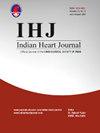Long term outcomes of drug-coated balloons versus drug-eluting stents in patients with small vessel coronary artery disease
IF 1.8
Q3 CARDIAC & CARDIOVASCULAR SYSTEMS
引用次数: 0
Abstract
Objective
Drug-eluting stents (DES) are a normative care of coronary stenosis. However, their efficacy was limited by stent thrombosis and in-stent restenosis especially in small vessel coronary artery disease (SvCAD). The aim of this study was to assess angiographic efficacy and clinical outcomes of drug coated balloons (DCB) as compared with DES in SvCAD setting.
Methods
A total of 100 SvCAD patients with percutaeous angioplasty of culprit coronary arteries <3 mm diameter and >70 % stenosis were enrolled in this study. The patients were categorized into DES arm and DCB arm. One year clinical outcomes were assessed. The primary endpoint was in-lesion late lumen loss (LLL). The secondary endpoints were vessel thrombosis, major bleeding, all-cause death and major adverse cardiac events (MACEs).
Results
One year clinical follow-up revealed that in-lesion LLL was significantly lower in DCB arm as compared with DES arm (p = 0.004). Composite MACE was significantly higher in DES group compared to DCB group (p < 0.001). Non-fatal myocardial infarction (MI), target lesion revascularization (TLR), and major bleeding in DES group were significantly higher than DCB group (p = 0.04 & p < 0.001 & p = 0.03, respectively). However, there was a numerically; but not significantly, higher incidence of cardiac death (p = 0.65), and vessel thrombosis (p = 0.18) in DES arm compared to DES arm.
Conclusion
In SvCAD setting, DCB has favourable angiographic and clinical outcomes; as evidenced by lower LLL and composite MACE at one year follow up, compared to DES.
药物包被球囊与药物洗脱支架在小血管冠状动脉疾病患者中的长期疗效
目的:药物洗脱支架(DES)是冠状动脉狭窄的规范治疗方法。然而,其疗效受到支架内血栓形成和支架内再狭窄的限制,特别是在小血管冠状动脉疾病(SvCAD)中。本研究的目的是评估药物包覆球囊(DCB)与DES在SvCAD环境下的血管造影效果和临床结果。方法:选取100例经皮冠状动脉冠脉直径< 3mm、狭窄程度小于70%的SvCAD患者作为研究对象。患者分为DES组和DCB组。评估一年的临床结果。主要终点是病变内晚期管腔损失(LLL)。次要终点为血管血栓形成、大出血、全因死亡和主要心脏不良事件(mace)。结果:1年临床随访显示,DCB组病变内LLL明显低于DES组(P = 0.004)。DES组综合MACE显著高于DCB组(P < 0.001)。DES组非致死性心肌梗死(MI)、靶区血运重建术(TLR)、大出血发生率均显著高于DCB组(P = 0.04、P < 0.001、P = 0.03)。然而,有一个数字;DES组心脏死亡(P = 0.65)和血管血栓形成(P = 0.18)发生率高于DES组,但无显著性差异。结论:在SvCAD环境下,DCB具有良好的血管造影和临床结果;与DES相比,随访一年的LLL和综合MACE均较低。
本文章由计算机程序翻译,如有差异,请以英文原文为准。
求助全文
约1分钟内获得全文
求助全文
来源期刊

Indian heart journal
CARDIAC & CARDIOVASCULAR SYSTEMS-
CiteScore
2.60
自引率
6.70%
发文量
82
审稿时长
52 days
期刊介绍:
Indian Heart Journal (IHJ) is the official peer-reviewed open access journal of Cardiological Society of India and accepts articles for publication from across the globe. The journal aims to promote high quality research and serve as a platform for dissemination of scientific information in cardiology with particular focus on South Asia. The journal aims to publish cutting edge research in the field of clinical as well as non-clinical cardiology - including cardiovascular medicine and surgery. Some of the topics covered are Heart Failure, Coronary Artery Disease, Hypertension, Interventional Cardiology, Cardiac Surgery, Valvular Heart Disease, Pulmonary Hypertension and Infective Endocarditis. IHJ open access invites original research articles, research briefs, perspective, case reports, case vignette, cardiovascular images, cardiovascular graphics, research letters, correspondence, reader forum, and interesting photographs, for publication. IHJ open access also publishes theme-based special issues and abstracts of papers presented at the annual conference of the Cardiological Society of India.
 求助内容:
求助内容: 应助结果提醒方式:
应助结果提醒方式:


